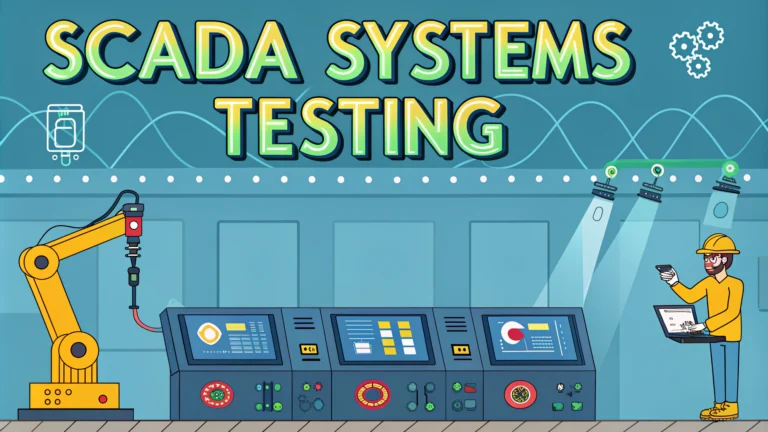SCADA penetration testing evaluates the security of industrial control systems that manage critical infrastructure, manufacturing processes, and utility operations.
Testing these systems requires specialized knowledge of industrial protocols, operational technology networks, and an understanding of how disruptions could impact physical processes.
This guide explores effective methods for conducting SCADA security assessments while maintaining system availability and preventing operational disruptions.
Key Components of SCADA Penetration Testing
- Network Architecture Analysis
- Protocol Testing (Modbus, DNP3, OPC)
- HMI Security Assessment
- PLC/RTU Configuration Review
- Historian Database Security
Pre-Testing Requirements
Written approval from system owners and operators must be obtained before starting any testing activities.
A detailed network map showing all SCADA components, communication paths, and protocols should be reviewed.
Testing schedules need coordination with maintenance windows to minimize operational risk.
Testing Methodology
- Passive Reconnaissance
- Network traffic analysis
- Protocol identification
- Device enumeration
- Active Testing
- Port scanning
- Service identification
- Vulnerability assessment
- Protocol Analysis
- Command injection testing
- Authentication bypass attempts
- Session handling review
Safety Considerations
Never perform denial-of-service testing on production SCADA systems.
Maintain constant communication with system operators during testing.
Have an immediate rollback plan for each test scenario.
Common Vulnerabilities
| Component | Common Issues |
|---|---|
| HMI | Default credentials, unpatched software |
| PLC/RTU | Weak authentication, unsecured protocols |
| Network | Unencrypted traffic, poor segmentation |
| Historians | SQL injection, insufficient access controls |
Testing Tools
- Wireshark – Protocol analysis
- Nmap – Network scanning
- Metasploit – Exploitation framework
- PLCScan – PLC discovery
- Modbus-CLI – Modbus protocol testing
Reporting and Documentation
Document all findings with clear remediation steps prioritized by risk level.
Include technical details and potential business impact for each vulnerability.
Provide specific configuration recommendations for securing identified weaknesses.
Next Steps for Secure SCADA Operations
Regular security assessments should be scheduled as part of maintenance procedures.
Implement a defense-in-depth strategy with multiple security controls.
Maintain updated documentation of all system changes and security configurations.
Contact industrial cybersecurity firms specializing in SCADA systems for professional assessments: Dragos, Claroty, or Nozomi Networks.
Vulnerability Management
Establish a systematic process for tracking and remediating discovered vulnerabilities.
Prioritize fixes based on risk levels and potential impact to operations.
- Critical vulnerabilities affecting safety systems
- High-risk issues that could disrupt operations
- Medium-risk configuration weaknesses
- Low-risk compliance items
Ongoing Monitoring
Implement continuous security monitoring to detect potential threats:
- Network traffic anomalies
- Unauthorized protocol usage
- Configuration changes
- Access control violations
Incident Response Planning
Pre-Incident Preparation
- Document response procedures
- Establish communication channels
- Define roles and responsibilities
- Test backup systems
Response Actions
- Incident containment steps
- System isolation procedures
- Evidence collection methods
- Recovery processes
Building Resilient SCADA Security
Integrate security testing into the broader industrial cybersecurity program.
Maintain partnerships with vendors and security firms for ongoing support.
Develop internal expertise through training and certification programs.
Review and update security controls as threats and technology evolve.
FAQs
- What is SCADA penetration testing?
SCADA penetration testing is a security assessment process that evaluates industrial control systems and operational technology networks for vulnerabilities, focusing on identifying security weaknesses in Supervisory Control and Data Acquisition (SCADA) systems. - Why is SCADA penetration testing important?
SCADA penetration testing is crucial because these systems control critical infrastructure like power plants, water treatment facilities, and manufacturing processes. A security breach could result in physical damage, service disruptions, or threats to public safety. - What are the main components tested during a SCADA penetration test?
Testing typically covers Human Machine Interfaces (HMIs), Programmable Logic Controllers (PLCs), Remote Terminal Units (RTUs), communication protocols, network architecture, access controls, and authentication mechanisms. - What tools are commonly used in SCADA penetration testing?
Common tools include Nmap for network discovery, Wireshark for protocol analysis, Metasploit for exploitation testing, and specialized SCADA testing tools like PLCScan and ModScan for industrial protocol testing. - What are the risks of performing SCADA penetration testing?
Risks include potential system crashes, disruption of industrial processes, equipment damage, and production losses. This is why testing often occurs in test environments or during planned maintenance windows. - What qualifications should a SCADA penetration tester have?
Testers should have industrial control systems knowledge, networking expertise, security testing experience, and understanding of industrial protocols like Modbus, DNP3, and OPC. Relevant certifications include GIAC GICSP and CompTIA PenTest+. - How often should SCADA penetration testing be performed?
SCADA systems should undergo penetration testing at least annually, after significant system changes, or when new vulnerabilities are discovered in industrial control system components. - What regulations require SCADA penetration testing?
Various regulations mandate SCADA security testing, including NERC CIP for power utilities, CFATS for chemical facilities, and ISA/IEC 62443 for industrial automation and control systems. - How is SCADA penetration testing different from regular IT penetration testing?
SCADA penetration testing requires specialized knowledge of industrial protocols and equipment, focuses on availability and safety over confidentiality, and must consider the potential physical impacts of testing activities. - What are the key deliverables of a SCADA penetration test?
Deliverables typically include detailed vulnerability reports, risk assessments, mitigation recommendations, and specific guidance for securing industrial control system components while maintaining operational reliability.







